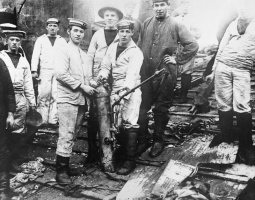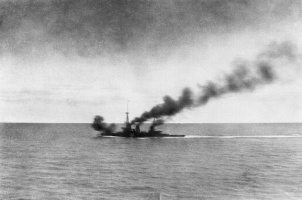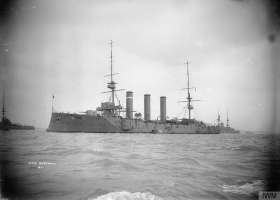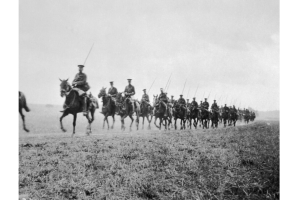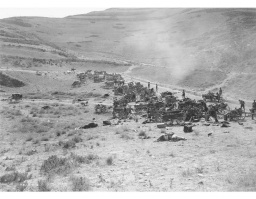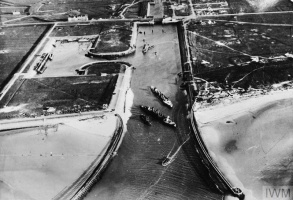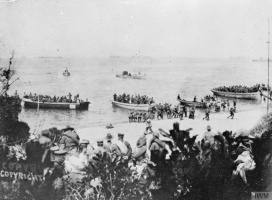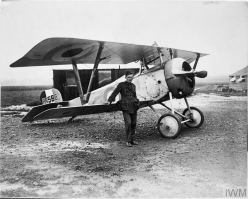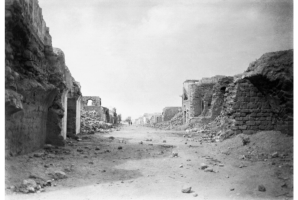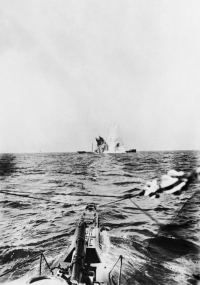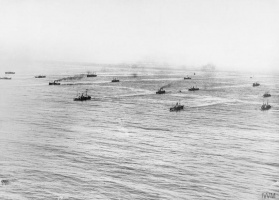Introduction↑
Before the outbreak of war in August 1914, Great Britain viewed itself primarily as a great naval power. The British Empire had expanded steadily during the second half of the 19th century, primarily through the country’s industrial might, the strength of the Royal Navy, trade and commerce, and a sense of imperial mission. This is not to say that the British Army was unimportant; it had fought in a variety of smaller conflicts in Africa, Asia and in the Crimean War. Despite some military reforms following the Boer War, Britain was largely unprepared for a major continental war: like other nations, its military leaders presumed that such a war would only last a matter of months.
↑
The Royal Navy suffered far fewer casualties than the British Army during the Great War, but its contribution was just as important. In some areas, it proved inferior to the Imperial German Navy, but, by the end of the conflict, it could legitimately claim to have made a significant contribution to victory due to its successful naval blockade of Germany. This was a turnaround in events: it had suffered some early setbacks, performed indifferently at the Battle of Jutland and been unable to solve the problem of German attacks on British shipping until later in the war. However, it did adapt successfully to the major challenges, and morale among officers and men remained high throughout the conflict. It operated in three major theatres: the North Sea, the English Channel and the Atlantic.
↑
When war broke out, the Royal Navy enjoyed fleet superiority over the Imperial German Navy: she had twenty-four dreadnought battleships, with eleven under construction (Germany had fifteen, with six under construction, although three were never completed); and nine battle cruisers, with one under construction (Germany had four). British naval thinking was still dominated by the idea of the decisive battle at sea. With such superior strength ranged against it, it was unlikely that the Imperial German Navy would risk an open confrontation. While there was no large-scale naval battle until Jutland, many of the minor naval engagements suggested German advantages in armour, firepower and command.
On 22 September 1914, three British armoured cruisers were sunk off the Dutch coast by a lone German submarine, with 1,600 British sailors drowned. On 27 October 1914, the battleship Audacious hit a mine off the coast of Ireland and sank. Off the coast of Chile, on 1 November 1914, a British squadron was overwhelmed by a German cruiser force which demonstrated greater accuracy in gunnery. Despite these setbacks, two battle cruisers were sent to the South Atlantic, where they engaged the German East Asian Squadron, commanded by Maximilian Graf von Spee (1861-1914), sinking two armoured and two light cruisers.
The principal theatre remained the North Sea. On 28 August 1914, the Battle of Heligoland Bight took place. Four British ships were damaged, but the Imperial Navy lost one destroyer, three cruisers and two torpedo boats sunk, and six other ships were damaged. This engagement suggested that the British still enjoyed naval superiority. A further clash in the North Sea took place on 24 January 1915 at the Battle of Dogger Bank, which ended in a British victory (although the British had a battle cruiser and a destroyer put out of action, the Germans suffered an armoured cruiser heavily damaged and an armoured cruiser sunk, and far heavier casualties in men).
The biggest clash of the war took place at the Battle of Jutland (31 May 1916), which saw the Germans successfully destroy a greater tonnage of naval vessels. However, they failed to achieve a decisive victory. The British Grand Fleet suffered 113,300 tons sunk, and the German High Seas Fleet 62,300 tons sunk. British fatalities were well over double those of the Germans. Although the battle demonstrated superior German gunnery, the British commander had succeeded in luring the Germans into a trap. However, Admiral John Jellicoe (1859-1935) did not pursue Admiral Reinhard Scheer (1863-1928). The Germans hailed the battle as a victory, although in strategic terms they had failed to reduce the numerical superiority of the Royal Navy and, thus, had not been able to win any freedom of action in the North Sea or elsewhere. The subject has caused heated debate ever since, even if it was essentially a tactical victory for the Germans.[1]
After Jutland, there were few serious naval engagements, other than the British attack on the port of Zeebrugge on 23 April 1918. Although the British were unable to block the canal exits used by German U-boats, the harbour was no longer capable of sheltering German destroyers. Despite the lack of further naval action, the Royal Navy succeeded in keeping the German High Seas Fleet bottled up in its ports for the rest of the war and, hence, unable to launch any decisive attacks.
The Battle against Submarines↑
One of the most critical aspects of naval warfare was the struggle to fend off German U-boats which, at the start of the war, were not hindered in their operations by Britain’s naval superiority in surface ships, an advantage which had lulled the British into a false sense of security. The British naval staff had failed to anticipate the threat submarines would pose; from February 1915 onwards, increasing submarine attacks were made against neutral as well as Allied merchant shipping.
Even before the German High Command decided at the beginning of 1917 to launch unrestricted submarine warfare, the tonnage of merchant shipping which the U-boats had sunk was causing concern. By the spring of 1917, one in four ships bound for Britain was being sunk. The solution to the problem, the convoy system, was to concentrate anti-submarine measures within the convoy itself: this combined depth-charges and guns on surface ships with an increase in the number of ships providing protection. This solution had been rejected by Jellicoe until desperation forced him to back down. By summer 1917, shipping losses began to fall. The criticism of the Admiralty’s performance during the war is most justified when it comes to their resistance to the convoy system.[2]
The British Army↑
A total of 5,704,416 men served in the British Army between August 1914 and November 1918. Given that the pre-war army had been a small professional force, which had strongly reflected the rigid Victorian and Edwardian class system, its expansion during the war led to a dramatic change in its institutional character. The pre-war officer establishment had been a mere 12,738 men; by November 1914, 3,627 of them had become casualties, indicating that changes were inevitable. As the old army was ground down, primarily on the Western Front, the new army which was mobilised (“Kitchener’s Army”), and, subsequently, the army created by the introduction of conscription in 1916, were faced with campaigns in other theatres of war, most notably in Africa, the Dardanelles, Mesopotamia, Palestine and Italy.
It should not be forgotten, either, that the British Army recruited 210,000 Irish volunteers during the course of the conflict (40,000 were killed). Three Irish divisions fought on several fronts: the 10th, 16th and 36th Divisions. The 36th (Ulster) Division was largely made up of Unionists and recruited from the Ulster Volunteer Force. If the majority of Protestants and Catholics in Ireland supported the war in August 1914, matters became more complicated following the Easter Rising of April 1916.[3]
As a volunteer and then a conscript army, the BEF was unable to match the professional ethos of the German Army. Hence, its tactics were indifferent in the first half of the war, while the performance of its commanders has also been criticised. But, subsequently, as a predominantly civilian force, it was able to compensate for early failings through the civilian expertise which flooded into its various branches of service. There seems little doubt that the more technical branches, such as the artillery, Signal Service, Tank Corps and Royal Engineers, benefited greatly from the industry expertise which a citizen army brought with it.
The Western Front↑
The majority of the divisions of the British Army were engaged during the war on the Western Front. In the frontier battles from 23 August to 1 September 1914, the BEF (with a strength of around 100,000) significantly delayed the German advance, performing well at the Battle of Mons and Le Cateau. However, it suffered heavy casualties in these early clashes, including in the First Battle of the Marne and Aisne counter-offensive. The final major battle of 1914, the First Battle of Ypres (October-November), largely led to the destruction of the pre-war army. Still, the British had assisted the French in stopping the initial German drive towards Paris.
The success in 1914 of Field Marshal Sir John French (1852-1925), the BEF commander-in-chief, was as much due to luck as it was to any particular military skill, and rested in part on the confused communications during the opening battles. However, he struggled more than the Germans with the unexpected challenges of trench warfare in 1915. When the BEF launched a major offensive at the Battle of Loos (25 September-8 October 1915), the British suffered around twice as many casualties as the Germans. The failure at Loos led to increasing dissatisfaction with French’s command. Sir Douglas Haig (1861-1928), one of French’s two corps commanders, began to agitate against him. Haig took over on 19 December 1915, holding command of the BEF until the end of the war.
British infantry tactics under French were too rigid and unimaginative; the BEF was also unprepared for trench warfare. There was an over-reliance on the power of artillery during offensives, even if artillery tactics improved rapidly during the course of the conflict, with the perfecting of counter-battery fire and sound-ranging techniques. Improvements in tactics did start to take place in 1916, however, with the introduction of various specialist training schools.
There were two major battles which continue to blight the reputation of Haig as the British commander-in-chief in France: the Battle of the Somme (1 July-18 November 1916) and the Third Ypres Offensive (31 July-10 November 1917). Their length, and the disputes over the casualty figures for the British divisions, make definitive judgements problematic. Yet it seems obvious that, at least during specific phases of both battles, Haig was over-optimistic.
Haig’s command was further overshadowed by the failure to anticipate the German counter-attack during the Battle of Cambrai (20 November-7 December 1917). Public anger at what appeared to be the squandering of a great victory through incompetence led to intense political pressure on him. One result was the purge which took place at the BEF General Headquarters in France: several senior officers were forced out, including the chief of intelligence, Brigadier General John Charteris (1877-1946), which weakened Haig’s position.
Perhaps as a result of this reputational damage, and because command proficiency had improved, Haig became more willing to delegate authority to his corps commanders during the course of 1918. Nonetheless, the dogged side to his personality helped the BEF survive the German March Offensive, paving the way for the series of counterattacks which formed the Hundred Days’ Campaign, which drove the German Army back to its frontiers.[4]
One of the strengths of the British Army was its capacity to create an environment conducive to genuine innovation. One of the best examples of this was the introduction of the tank on 15 September 1916 during the Battle of the Somme. During the war, Britain produced 2,818 tanks. The tank was not a “war-winning” weapon, yet it proved an important morale-booster on the home front; and tanks did make a significant contribution during the Hundred Days’ Campaign. Given the design weaknesses in the first machine, the Mark I, technical development during the war was remarkable: the Medium “A” Whippet and Mark V machines proved themselves extremely versatile under the conditions of more mobile warfare in 1918.
Other Theatres↑
The most significant campaigns in other theatres took place in the Dardanelles (also referred to as Gallipoli), Mesopotamia, Sinai and Palestine, Salonika, East Africa and on the Italian Front.
The Gallipoli Campaign symbolises the poor early performance of British command in the war. Planning was over-optimistic. It overestimated the ability of the navy to silence the Turkish shore-based gun emplacements. Command indecision during the initial landings at Anzac Cove and Cape Helles in April 1915 virtually ensured failure. While a landing at Suvla Bay in August 1915 was intended to break the deadlock, the new forces were unable to break through the Turkish defences. Furthermore, the Allied force had to fend off furious Turkish attacks. In December 1915 and January 1916, the troops at Gallipoli were evacuated successfully. The early failure was caused by poor command, the advantages held by the Turkish defenders and the lack of Allied experience in amphibious operations. The fact that the evacuation was conducted successfully indicated an improvement in military skill during the course of the campaign.[5]
Another campaign against Turkish forces was in Mesopotamia, conducted by a combined British-Indian force, which entered Basra on 25 November 1914. Again, typically for this phase of the war, a poor command decision led to a disastrous defeat for the British at the end of the siege of Kut-al-Amara (December 1915-April 1916) when the British-Indian force of 13,000 men surrendered, later suffering appalling brutality at the hands of their captors. However, a new offensive commenced in December 1916 which led to the capture of Kut (24 February 1917). Baghdad fell the following month. While subsequent progress was slow, Mosul was captured in October 1918 as the Ottoman Empire collapsed. The cost of the campaign was high in terms of casualties (around 100,000, with 53,000 deaths).
The campaign in Sinai and Palestine revealed similar shortcomings. The Egyptian Expeditionary Force, under the command of General Sir Archibald Murray (1860-1945), succeeded in the battles of Romani (August 1916), Magdhaba (December 1916) and Rafa (January 1917), but met with failure at the First (March 1917) and Second (April 1917) Battles of Gaza. Murray was replaced by General Sir Edmund Allenby (1861-1936), who defeated the Turks at the Third Battle of Gaza (October 1917), but he too made slow progress before winning the Battle of Megiddo (September 1918). The Turkish defenders proved tough and resourceful opponents; the campaign cost the British 15,000 dead.[6]
In fact, the “peripheral theatres” reflected many trends that also appeared on the Western Front. The weaknesses in the BEF in terms of tactics, organisation and command could be observed in the “other theatres”. By 1916, lessons and new tactics from different theatres were starting to be shared.
Air Forces↑
Both the army and the navy had their own air forces at the start of the conflict: for the army, the Royal Flying Corps (RFC), consisting of five squadrons, was established in April 1912; the navy formed the Royal Naval Air Service (RNAS) on 1 July 1914 (with ninety-three aircraft, six airships and two balloons). During the first twelve months of the war, both air forces operated as a naval and military wing of the Royal Flying Corps. On 1 August 1915, the RNAS came under complete naval control. The inter-service rivalry which ensued had a negative impact on aircraft procurement; partly in response to this, on 1 April 1918, the Royal Air Force was formed. The central figure in the war was undoubtedly Hugh Trenchard (1873-1956), who commanded the RFC in France (August 1915-January 1918), was chief of the air staff (January-April 1918), and then became general officer commanding of the Independent Force and commander-in-chief of the Inter-Allied Independent Air Force (June-November 1918).
In the early phase of the war, when British aircraft were technically inferior to German machines, air activity was largely restricted to reconnaissance and artillery cooperation. But as the war progressed, ground-air support and bombing missions became an integral part of British operations. By the time of the German Spring Offensive in March 1918, the RFC was starting to match the German air force. RFC/RAF units served mainly on the Western Front, but they did contribute to operations in Mesopotamia, East Africa, Palestine and Italy. At the end of the war, 5,182 pilots were serving in the RAF; total casualties for air force personnel were 9,378 killed and 7,245 wounded.[7]
Conclusion↑
When Britain went to war in 1914, strategy assumed the Royal Navy would keep the maritime routes open, and that the British would make a small contribution to the war on land until the Central Powers were exhausted; then, the army would take the lead in a final, victorious offensive. This would allow Britain to take charge at the peace negotiations. Yet, as in France, Russia and Germany, by 1917 it had become clear that the original strategy had failed. David Lloyd George’s (1863-1945) War Cabinet could, at least in theory, have decided to reduce the number of offensives undertaken in 1917; however, they were unable to dismiss their senior military advisors, who were protected by Unionist politicians. Although the senior military figures in London were correct that the war would ultimately be won in France, they were unable to separate this from the belief that big offensives were the only way to maintain pressure on the enemy.
While it would be an oversimplification to describe British field strategy until the end of 1917 as one of “attrition”, the casualties sustained do give this impression. Over 700,000 British soldiers died in the conflict, with a disproportionate number coming from the middle and upper classes.[8] For an island nation, the scale of this sacrifice proved a severe shock. The performance in land warfare of the divisions of the British Army, and of its technical, support and subordinate formations, was an inevitable product of a variety of pressures: the lack of any recent employment of a mass army, the fact that the General Staff had only been formed in 1904, and the myriad of tactical and operational challenges which the war posed.
In naval warfare, Britain’s admirals proved remarkably stubborn when it came to the proposed use of the convoy system as the best counter to the U-boat menace. That challenge aside, the fact that the Admiralty stuck rigidly to its conservative strategy of maintaining the blockade against Germany proved to be a major contribution to victory. With casualties of between 43,000 and 44,000 sailors in the war, most of the dying was done by soldiers.
Since British strategy was based, for part of the war, on the desire to secure victory without an unnecessary level of financial sacrifice, at one level it can be seen as an abject failure. Still, Britain’s military performance, seen within the context of total war, was, ultimately, very proficient. The country proved remarkably successful both at the mobilisation of the population for the armed services and industrial production, and in the employment of science, which included the civilian contribution to the quality of naval and military intelligence. Despite significant setbacks, the Royal Navy achieved what was required of it. If the army performed poorly in the first half of the war, it underwent a process of reform in 1916 and 1917, gradually improving its tactical performance. By 1918, its coordination of infantry, artillery, tanks and aircraft through improved communications technology and doctrine led to victory in every theatre.[9]
Alaric Searle, Nankai University
Section Editor: Adrian Gregory
Notes
- ↑ The most recent treatment, and probably the most thorough to date, is Brooks, John: The Battle of Jutland, Cambridge 2016.
- ↑ Two useful overviews of this subject are to be found in Halpern, P.G.: A Naval History of World War I, London 1994, pp. 335-380, 403-441; and Hough, Richard: The Great War at Sea 1914-1918, Edinburgh 2000, pp. 169-189, 298-321.
- ↑ For this subject, see Bowman, Tim: The Irish Regiments in the Great War. Discipline and Morale, Manchester 2003.
- ↑ Haig has been the subject of numerous biographies. The most balanced remains Harris, J.P.: Douglas Haig and the First World War, Cambridge 2008.
- ↑ In addition to the two volumes Committee of Imperial Defence: Military Operations. Gallipoli, Inception of the Campaign to May 1915, volume 1, London 1929 and Committee of Imperial Defence: Military Operations. Gallipoli, May 1915 to the Evacuation, volume 2, London 1932. On Gallipoli see also Hickey, Michael: Gallipoli, London 1995.
- ↑ A fresh look at the campaigns in Mesopotamia, Sinai and Palestine is provided in Johnson, Rob: The Great War and the Middle East, Oxford 2016.
- ↑ For the development of British air power on the Western Front, the most up-to-date monograph is Pugh, James: The Royal Flying Corps, the Western Front and Control of the Air, 1914-1918, Abingdon 2017.
- ↑ For casualty statistics, but also accurate statistics on other aspects, see War Office: Statistics of the Military Effort of the British Empire during the Great War, London 1922.
- ↑ Two outstanding recent works which explain the improvements in training and communications are Fox, Aimee: Learning to Fight. Military Innovation and Change in the British Army, 1914-1918, Cambridge 2017; and Hall, Brian N.: Communications and British Operations on the Western Front, 1914-1918, Cambridge 2017.
Selected Bibliography
- Badsey, Stephen: Doctrine and reform in the British cavalry, 1880-1918, Aldershot 2008: Ashgate.
- Beach, Jim: Issued by the General Staff. Doctrine writing at British GHQ, 1917-1918, in: War in History 19/4, 2012, pp. 464-491.
- Beach, Jim: Haig's intelligence. GHQ and the German Army, 1916-1918, Cambridge; New York 2013: Cambridge University Press.
- Beckett, Ian / Bowman, Timothy / Connelly, Mark: The British Army and the First World War, Cambridge 2017: Cambridge University Press.
- Boff, Jonathan: Winning and losing on the Western Front. The British Third Army and the defeat of Germany in 1918, Cambridge; New York 2012: Cambridge University Press.
- Bowman, Timothy: The Irish regiments in the Great War. Discipline and morale, Manchester 2004: Manchester University Press.
- Brooks, John: The Battle of Jutland, Cambridge 2016: Cambridge University Press.
- Brown, Ian M.: British logistics on the Western Front, 1914-1919, Westport 1998: Praeger.
- Ferris, John: The British army and signals intelligence during the First World War, Stroud 1992: A. Sutton.
- Fox, Aimee: Learning to fight. Military innovation and change in the British army, 1914-1918, Cambridge 2017: Cambridge University Press.
- French, David: The strategy of the Lloyd George coalition, 1916-1918, Oxford; New York 1995: Clarendon Press; Oxford University Press.
- Great Britain, War Office (ed.): Statistics of the military effort of the British Empire during the Great War, 1914-1920, London 1922: His Majesty's Stationery Office.
- Hall, Brian N.: Communications and British operations on the Western Front, 1914-1918, Cambridge; New York 2017: Cambridge University Press.
- Halpern, Paul G.: A naval history of World War I, Annapolis 1994: Naval Institute Press.
- Harris, J. P.: Douglas Haig and the First World War, Cambridge; New York 2008: Cambridge University Press.
- Hickey, Michael: Gallipoli, London 1995: John Murray.
- Hodgkinson, Peter E.: British infantry battalion commanders in the First World War, Farnham 2015: Ashgate.
- Hough, Richard: The Great War at sea, 1914-1918, Oxford; New York 1983: Oxford University Press.
- Johnson, Robert: The Great War and the Middle East. A strategic study, Oxford 2016: Oxford University Press.
- Prior, Robin / Wilson, Trevor: Command on the Western Front. The military career of Sir Henry Rawlinson 1914-1918, Barnsley 2004: Leo Cooper.
- Pugh, James: The Royal Flying Corps, the Western Front and the control of the air, 1914-1918, London; New York 2017: Routledge.
- Robbins, Simon: British generalship on the Western Front 1914-18. Defeat into victory, London 2006: Routledge.
- Sheffield, Gary: Command and morale. The British Army on the Western Front 1914-1918, Barnsley 2014: The Praetorian Press.
- Travers, Timothy: How the war was won. Command and technology in the British army on the Western Front, 1917-1918, Barnsley 2005: Pen & Sword Military Classics.





